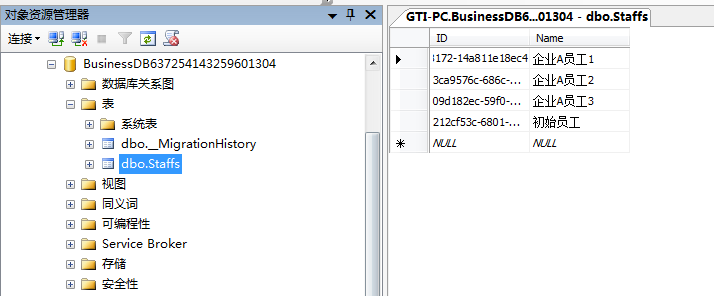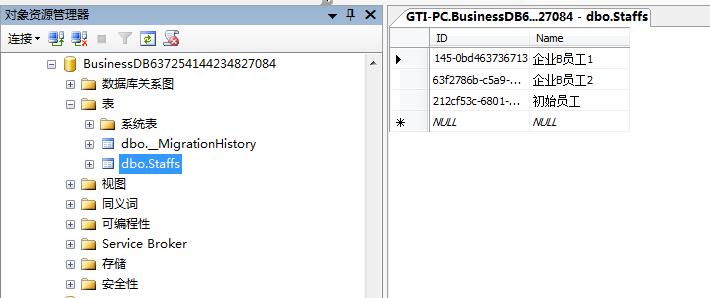基于EntityFramework 6 Code First实现简单的多租户系统,支持动态建库,分库,数据库自动迁移
一、前言
公司原本有一个“xx系统”,ORM使用EntityFramework,Code First模式。该系统是针对某个客户企业的,现要求该系统支持多个企业使用,但是又不能给每个企业部署一份(难以维护),只能想办法从代码层面去解决这个问题。
二、思路
- 在原有的数据表增加外键,标记该数据属于哪个企业。这代码改动会非常大,之前的查询修改代码都需要增加外键筛选的逻辑。这显然不合理。
- 动态分库。每个企业注册时,为他生成一个独立的数据库,企业登录时切换到他对应的数据库。这样就完全不用修改以前的业务代码,只需要考虑企业数据库切换的问题。
三、实现
那么EntityFramework Code First模式怎么实现动态分库的功能呢?
- 首先建立一个主库,主库只存放企业用户的数据,包括企业登录名,密码,对应的数据库名 等等... 主库只有一个。
- 业务数据库,在企业注册的时候动态创建,业务数据库可以有多个,也可以放到不同的服务器。
- 企业登录时,读取主库,拿到业务数据库名称,然后保存到用户session中(也可以是别的缓存),该用户的后续请求都基于此数据库。
为了简单我建立了一个demo项目:

主库模型放在XHZNL.EFDynamicDatabaseBuilding.MasterEntity里面,主库只有一个企业表:Enterprise:
using System;
using System.Collections.Generic;
using System.ComponentModel.DataAnnotations;
using System.ComponentModel.DataAnnotations.Schema;
using System.Linq;
using System.Text;
using System.Threading.Tasks;
namespace XHZNL.EFDynamicDatabaseBuilding.MasterEntity
{
/// <summary>
/// 企业
/// </summary>
public class Enterprise
{
/// <summary>
/// ID
/// </summary>
[Required]
public Guid ID { get; set; }
/// <summary>
/// 企业名称
/// </summary>
[Required]
[Column(TypeName = "NVARCHAR")]
[MaxLength(50)]
public string Name { get; set; }
/// <summary>
/// 企业数据库名称
/// </summary>
[Required]
[Column(TypeName = "NVARCHAR")]
[MaxLength(100)]
public string DBName { get; set; }
/// <summary>
/// 企业 账号
/// </summary>
[Required]
[Column(TypeName = "NVARCHAR")]
[MaxLength(20)]
public string AdminAccount { get; set; }
/// <summary>
/// 企业 密码
/// </summary>
[Required]
[Column(TypeName = "NVARCHAR")]
[MaxLength(50)]
public string AdminPassword { get; set; }
}
}
XHZNL.EFDynamicDatabaseBuilding.MasterEntity.Services.BaseService:
using System;
using System.Collections.Generic;
using System.Data.Entity;
using System.Linq;
using System.Text;
using System.Threading.Tasks;
using XHZNL.EFDynamicDatabaseBuilding.Common;
namespace XHZNL.EFDynamicDatabaseBuilding.MasterEntity.Services
{
public class BaseService
{
/// <summary>
/// 获取context
/// </summary>
/// <returns></returns>
internal MasterDBContext GetDBContext()
{
try
{
var context = new MasterDBContext();
if (!context.Database.Exists())
{
context.Database.Create();
var dbInitializer = new MigrateDatabaseToLatestVersion<MasterDBContext, Migrations.Configuration>(true);
dbInitializer.InitializeDatabase(context);
}
if (!context.Database.CompatibleWithModel(false))
{
var dbInitializer = new MigrateDatabaseToLatestVersion<MasterDBContext, Migrations.Configuration>(true);
dbInitializer.InitializeDatabase(context);
}
return context;
}
catch (Exception ex)
{
return null;
}
}
}
}
XHZNL.EFDynamicDatabaseBuilding.MasterEntity.Services.EnterpriseService:
using System;
using System.Collections.Generic;
using System.Linq;
using System.Text;
using System.Threading.Tasks;
using XHZNL.EFDynamicDatabaseBuilding.Common;
namespace XHZNL.EFDynamicDatabaseBuilding.MasterEntity.Services
{
/// <summary>
/// 企业服务
/// </summary>
public class EnterpriseService : BaseService
{
public static readonly EnterpriseService Instance = new EnterpriseService();
private EnterpriseService() { }
/// <summary>
/// 根据账号密码 获取 企业
/// </summary>
/// <param name="account"></param>
/// <param name="password"></param>
/// <returns></returns>
public Enterprise Get(string account, string password)
{
try
{
using (var context = GetDBContext())
{
var model = context.Enterprises.FirstOrDefault(m => m.AdminAccount == account && m.AdminPassword == password);
if (model != null)
{
//设置当前业务数据库
CommonHelper.Instance.SetCurrentDBName(model.DBName);
}
return model;
}
}
catch (Exception ex)
{
return null;
}
}
/// <summary>
/// 添加企业
/// </summary>
/// <param name="id"></param>
/// <returns></returns>
public bool Add(Enterprise enterprise)
{
try
{
using (var context = GetDBContext())
{
enterprise.ID = Guid.NewGuid();
enterprise.DBName = "BusinessDB" + DateTime.Now.Ticks;
context.Enterprises.Add(enterprise);
return context.SaveChanges() > 0;
}
}
catch (Exception ex)
{
return false;
}
}
}
}
XHZNL.EFDynamicDatabaseBuilding.Common.CommonHelper:
using System;
using System.Collections.Generic;
using System.Linq;
using System.Runtime.Remoting.Messaging;
using System.Text;
using System.Threading.Tasks;
namespace XHZNL.EFDynamicDatabaseBuilding.Common
{
public class CommonHelper
{
public static readonly CommonHelper Instance = new CommonHelper();
private CommonHelper() { }
/// <summary>
/// 获取当前数据库
/// </summary>
/// <returns></returns>
public string GetCurrentDBName()
{
var key = "CurrentDBName";
string name = null;
if (System.Web.HttpContext.Current != null && System.Web.HttpContext.Current.Session != null)
{
name = System.Web.HttpContext.Current.Session[key].ToString();
}
else
{
name = CallContext.GetData(key).ToString();
}
if (string.IsNullOrEmpty(name))
throw new Exception("CurrentDBName异常");
return name;
}
/// <summary>
/// 设置当前数据库
/// </summary>
/// <param name="name"></param>
public void SetCurrentDBName(string name)
{
var key = "CurrentDBName";
if (System.Web.HttpContext.Current != null && System.Web.HttpContext.Current.Session != null)
{
System.Web.HttpContext.Current.Session[key] = name;
}
else
{
CallContext.SetData(key, name);
}
}
}
}
web.config配置一下业务数据库的连接信息:

这个可以根据实际业务修改,分布到不同的服务器,这里只是为了演示。
业务数据库模型放在XHZNL.EFDynamicDatabaseBuilding.BusinessEntity里面,这里只有一个员工表
using System;
using System.Collections.Generic;
using System.ComponentModel.DataAnnotations;
using System.ComponentModel.DataAnnotations.Schema;
using System.Linq;
using System.Text;
using System.Threading.Tasks;
namespace XHZNL.EFDynamicDatabaseBuilding.BusinessEntity
{
/// <summary>
/// 员工
/// </summary>
public class Staff
{
/// <summary>
/// ID
/// </summary>
[Required]
public Guid ID { get; set; }
/// <summary>
/// 员工名称
/// </summary>
[Required]
[Column(TypeName = "NVARCHAR")]
[MaxLength(50)]
public string Name { get; set; }
}
}
数据库context:
using System;
using System.Collections.Generic;
using System.Data.Entity;
using System.Linq;
using System.Text;
using System.Threading.Tasks;
namespace XHZNL.EFDynamicDatabaseBuilding.BusinessEntity
{
//[DbConfigurationType(typeof(MySql.Data.Entity.MySqlEFConfiguration))]//使用mysql时需要这个
internal class BusinessDBContext : DbContext
{
public BusinessDBContext() : base("name=BusinessDB")
{
Database.SetInitializer<BusinessDBContext>(null);
}
//修改上下文默认构造函数
public BusinessDBContext(string connectionString)
: base(connectionString)
{
}
/// <summary>
/// 员工
/// </summary>
public DbSet<Staff> Staffs { get; set; }
}
}
XHZNL.EFDynamicDatabaseBuilding.BusinessEntity.Migrations.Configuration:可以放一些种子数据...
namespace XHZNL.EFDynamicDatabaseBuilding.BusinessEntity.Migrations
{
using System;
using System.Data.Entity;
using System.Data.Entity.Migrations;
using System.Linq;
internal sealed class Configuration : DbMigrationsConfiguration<XHZNL.EFDynamicDatabaseBuilding.BusinessEntity.BusinessDBContext>
{
public Configuration()
{
AutomaticMigrationsEnabled = true;
AutomaticMigrationDataLossAllowed = true;
//SetSqlGenerator("MySql.Data.MySqlClient", new MySql.Data.Entity.MySqlMigrationSqlGenerator());//使用mysql时需要这个
}
protected override void Seed(XHZNL.EFDynamicDatabaseBuilding.BusinessEntity.BusinessDBContext context)
{
// This method will be called after migrating to the latest version.
// You can use the DbSet<T>.AddOrUpdate() helper extension method
// to avoid creating duplicate seed data.
var staff = new Staff() { ID = Guid.Parse("212cf53c-6801-4c00-b36b-996ac9809e04"), Name = "初始员工" };
context.Staffs.AddOrUpdate(staff);
context.SaveChanges();
}
}
}
关键的分库,建库,更新数据库代码在XHZNL.EFDynamicDatabaseBuilding.BusinessEntity.Services.BaseService,任何的模型修改都能在程序运行时自动更新到数据库:
using System;
using System.Collections.Generic;
using System.Data.Entity;
using System.Linq;
using System.Text;
using System.Threading.Tasks;
using XHZNL.EFDynamicDatabaseBuilding.Common;
namespace XHZNL.EFDynamicDatabaseBuilding.BusinessEntity.Services
{
public class BaseService
{
/// <summary>
/// 获取context
/// </summary>
/// <returns></returns>
internal BusinessDBContext GetDBContext()
{
try
{
//mysql连接字符串
//var connectionString = $"Data Source={AppConfig.DB_DataSource};Port={AppConfig.DB_Port};Initial Catalog={CommonHelper.Instance.GetCurrentDBName()};User ID={AppConfig.DB_UserID};Password={AppConfig.DB_Password};";
//sqlserver连接字符串
var connectionString = $"Data Source={AppConfig.DB_DataSource},{AppConfig.DB_Port};Initial Catalog={CommonHelper.Instance.GetCurrentDBName()};User ID={AppConfig.DB_UserID};Password={AppConfig.DB_Password};";
var context = new BusinessDBContext(connectionString);
//数据库是否存在 不存在则创建
if (!context.Database.Exists())
{
context.Database.Create();
var dbInitializer = new MigrateDatabaseToLatestVersion<BusinessDBContext, Migrations.Configuration>(true);
dbInitializer.InitializeDatabase(context);
}
//数据库接口是否和模型一致 不一致则更新
if (!context.Database.CompatibleWithModel(false))
{
var dbInitializer = new MigrateDatabaseToLatestVersion<BusinessDBContext, Migrations.Configuration>(true);
dbInitializer.InitializeDatabase(context);
}
return context;
}
catch (Exception ex)
{
return null;
}
}
}
}
其他的数据访问类继承BaseService,通过GetDBContext()方法获取context,这样确保得到正确的业务数据库。
四、效果
- 运行web项目:

此时数据库中只有一个主库:

- 点击注册企业:


注册2个企业用于测试
此时主库已有了2条企业数据:

- 分别用test1,test2登录,并添加员工数据:




企业登录后已经生成了对应的业务库

- 数据正确添加读取:


五、总结:
以上关于EntityFramework分库的核心就是通过动态构建connectionString,来得到context。至于如何动态构建,方法有很多,以上代码只是最简单的实现。代码在:https://github.com/xiajingren/EFDynamicDatabaseBuilding
——本文使用【Typora】+【EasyBlogImageForTypora】编辑
欢迎关注我的公众号,一起学习。
如果本文对您有所帮助,您可以点击右下方的【推荐】按钮支持一下;文中如有不妥之处,还望指正,非常感谢!!!

作者:xhznl
出处:http://www.cnblogs.com/xhznl/
文章可以转载,但请注明出处



